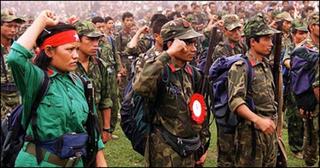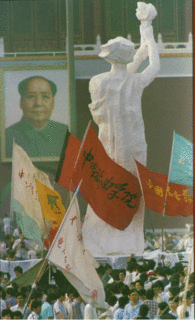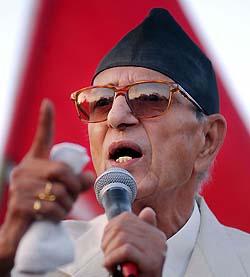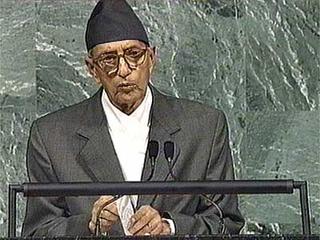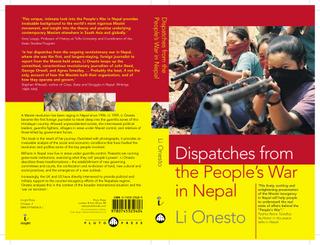 Li Onesto: I am sending you a recent piece I wrote in response to an article that appeared in Harper’s (a progressive magazine in the US). I think this is a very important because it takes on some of the main disinformation themes that have been put out there to attack the People’s War in Nepal. ......... I am also sending you information about my book, Dispatches from the People’s War in Nepal.
Li Onesto: I am sending you a recent piece I wrote in response to an article that appeared in Harper’s (a progressive magazine in the US). I think this is a very important because it takes on some of the main disinformation themes that have been put out there to attack the People’s War in Nepal. ......... I am also sending you information about my book, Dispatches from the People’s War in Nepal. From: Paramendra Kumar Bhagat paramendra@yahoo.com
Date: Sat, 14 May 2005 12:24:25 -0700 (PDT)
To: LiO@lionesto.net
Subject: From a progressive Nepali blogger
Hello Li. I have read a lot of what you have written about Nepal. I commend your work. You might be the only person to have successfully thrown a positive light on some of the achievements of the Maoists.
I would really like to correspond with you. Can I eInterview you for my blog?
http://demrepubnepal.blogspot.com/
Are you in eContact with Prachanda? What about Baburam? I really would like to know where they stand on my proposed constitution.
http://demrepubnepal.blogspot.com/2005/05/proposed-constitution.html
http://www.paramendra.com
Refutation of Harper's Article on the Maoists in Nepal
Telling Lies in Kathmandu
by Li Onesto
Revolution #007, June 26, 2005, posted at revcom.us
Eliza Griswold's article, "It's Not Easy Here in Kathmandu--Caught between the Maoist rebels and the king's army" appeared in the May 2005 issue of Harper's magazine. I have traveled into the guerrilla zones in Nepal and closely follow developments in this conflict, and I'm constantly angered by this kind of journalism which contributes to a growing mountain of harmful disinformation.
The Lie of "Caught in the Middle"
People like Eliza Griswold are very disturbed by the reality that the Communist Party of Nepal (Maoist) now controls most of Nepal's countryside, their People's Liberation Army is able to mobilize thousands of guerrillas in battle against the Royal Nepalese Army (RNA), and in areas run by new revolutionary governments, they are radically changing the economic, political, and cultural life of millions of poor peasants.1 The Maoists began their People's War in 1996 and, ever since, Nepal's ruling class has been in constant crisis over how to deal with this insurgency which is now threatening to seize power. But instead of a serious discussion about why the Maoists have grown so rapidly, Griswold's theme, indicated by her subtitle, is that the majority of people in Nepal are caught in the middle--between a brutal government guilty of horrendous human rights abuses, and Maoists who are even worse.
To paint this scenario, Griswold introduces: an 18-year-old girl in the RNA; an RNA Brigadier General trained at Fort Leavenworth; the editor of a conservative Kathmandu newspaper; the U.S. ambassador to Nepal; a doctor and several people at a center set up only for "victims of Maoist torture" (no victims of the RNA); villagers in a contested area in the Terai; two girls and the principal at Kathmandu Valley school who say they were "abducted by Maoists"; a human rights researcher who says "no one wants to abandon Nepal to the Maoists."
Almost all of these two dozen or so people are by definition hostile to the Maoists and were in cities or other areas under government control. Sweeping censorship and systematic disinformation by the Nepalese government2 have had a huge impact on people's opinions and what they know and don't know about the Maoists, not only internationally but within Nepal itself, and this is especially true among many of the people Griswold quotes.
Griswold talks to three Maoists--two rebels she arranges to meet along the roadside and a journalist who left the Maoists, was imprisoned and tortured by the government and now writes for a Maoist newspaper. There is a quote from a leader in the CPN(M). But other than this, there are no views from Maoist supporters and no conversations with people living in Maoist base areas.
In Griswold's "caught in the middle" scenario, Maoist supporters are simply written off as if they are not part of the people. But the People's Liberation Army is made up of tens of thousands of common peasants who are not "caught in the middle" but have joined the insurgency. And many more are participating in the new revolutionary governments.
In Nepal over 85% of the people are peasants in the countryside, desperately poor, malnourished, and exploited by corrupt officials, landlords, and moneylenders. Lower castes and oppressed ethnic groups face systematic discrimination under a rigid caste system. Women are intensely suppressed and treated as inferior in every facet of society. A king controls the army and an oppressive monarchy is deeply embedded in the ruling structures of society. The whole country is subordinate to, dependent on, and dominated by India and imperialist countries like the U.S.
The Maoist revolution aims to get rid of all this. The Nepalese regime rules over, enforces and is fighting to preserve all this. Are the masses of people, as Griswold argues, caught between these two fires? No! The Maoists are organizing and providing leadership to millions who are brutally and systematically oppressed by the system AND who are inspired by and support the Maoists' vision and concrete program for building a new liberating society.
Nepal's ruling class has not and cannot solve the basic problems of food, water, sanitation, and health care because this requires tearing up the existing economic, social, and political relationships within Nepalese society and between Nepal and other countries. While Griswold acknowledges the dire situation of the masses, she wants us to believe the Maoists are cynically "taking advantage" of and manipulating this. In truth, the Maoists have support in Nepal exactly because they are addressing the deeply embedded oppression people face. In areas they control real changes are taking place: redistribution of land, equal rights for women, end to the caste system, autonomy for oppressed ethnic groups, healthcare, education and the building of roads and bridges. Even a young woman in the government's army tells Griswold: "The Maoists have high principles.so they attract everyone who is interested in struggling for equality. Some of my friends from my village have joined them. If I lived in the village, I'd be a Maoist, too."
When I was in the guerrilla zones in 1999, I was very struck by the composition of the PLA squads and platoons. They were overwhelmingly made up of those on the very bottom of society--lower castes, ethnic minorities, peasant youth and many, many young women. This says a lot about the nature of this revolution.
Revolutionary Authority
Let's get right down to it. People like Griswold may talk about government repression, deep poverty, and powerlessness among the poor. But they don't uphold the right of the people to really struggle against any of this. And what they hate a lot more than the oppressive status quo is revolutionary authority being exercised to actually transform the prevailing economic and social relations, as well as the culture and thinking that goes along with this oppressive setup. In effect, this is an argument that the people should just accept their horrible conditions and ends up justifying crushing the revolutionary struggle.
Griswold mentions that the Maoists hold power in 73 of the 75 political districts, but is content to stay in the disinformation zones and never goes into areas under Maoist control--which constitute most of Nepal! She doesn't even talk about what's happening in these areas. Instead, the view running through her article is that Maoist rule is a totalitarian and horrible thing.
But what is actually being accomplished under Maoist authority in Nepal? Another way to pose this is: What is the power the Maoists have achieved through armed struggle good for?
I could go into a lot of examples here. But just take the question of women--which revealingly Griswold doesn't talk about, even though the huge participation of women in this revolution is a fact widely acknowledged.
Feudal traditions like arranged marriages, dowries, and polygamy are enforced in many ways and under a mixture of feudal and capitalist rules; women's bodies are owned, controlled, and bargained over in everything from marriage to sex trafficking. Religious and cultural practices promote and perpetuate male domination. And everywhere a woman turns, her freedom and independence is policed and smothered. For women to be free of all this, the basic economic relations of land ownership in the countryside have to be upended. Control has to be taken out of the hands of the religious, political, and military forces which back up the tyranny of local landlords, corrupt politicians, and moneylenders. Social and cultural institutions which provide a foundation for the patriarchal control of fathers, brothers, and mother-in-laws have to be done away with. The whole education system has to be revolutionized.
And this is exactly what revolutionary authority and power is good for! In the Maoist base areas land is being redistributed, and for the first time women own land. Arranged marriages, polygamy, and other feudal traditions oppressive to women are no longer practiced. Wife beating and rape are severely punished by people's courts. Women are given the right to divorce, go to school, and fight in local militias as well as the People's Liberation Army. And women are equal participants in the new economic, political, and social life of the villages.
Extremely significant and liberating changes are taking place in the Maoist base areas, but Griswold cynically writes them off. When she sees men building the roof of a new school, her only response is to question why the Maoists charge a $3 tuition. For literally hundreds of millions of people around the world, life is dictated, ruined and suppressed by horrible caste distinctions. No amount of capitalist globalization and westernization has gotten rid of this. But Griswold doesn't even comment when she hears that in the Maoist areas caste distinctions have been abolished and intercaste marriages are common.
The Nepalese people need revolutionary change--not a "solution" within the present order which has as its foundation exploitative economic relations and intense social inequality, as well as an entrenched dependence on foreign powers. Daily life for the majority of people concretely and repeatedly demonstrates this--which is why the Maoists have real support.
Tales of Coercion and Terror
Griswold's analysis includes quoting a man who tells her, "99 percent of the country don't like the Maoists"--a ridiculous claim given the growth of the insurgency, which even those unsympathetic to the guerrillas admit. But this goes along with Griswold's claim that the Maoists only get support through coercion and terror. She says: "The Maoists have begun to demand that every family sacrifice one person to their cause."
A reporter in Nepal for the Maoist newspaper Janadesh responded to Griswold's charge, saying,
"The Maoists do not force anybody to fight. How can anyone force a man or woman to fire a gun? You need courage, dedication and spirit of sacrifice to become a fighter in the People's Liberation Army. It's not like playing video war games on a computer. It's a life and death struggle. Only the most courageous men and women can prepare themselves to fight for revolution. There is a saying in Nepal that 'a carried dog cannot hunt a deer.'"
Think for a moment. The guerrillas started off small and up against the brutal coercion of a regime backed by India and the U.S. How could the Maoists have achieved their current military and political strength without the genuine support and participation of thousands who believe in the goals of the revolution and on this basis are willing to go into battle and risk their lives?
There is video, photographs, and reports of massive Maoist rallies in the countryside.3 Reporters who have been in Maoist-controlled areas have written about the guerrillas organizing people to build roads, bridges, and schools.4 During the 2003 negotiations 30,000 people attended a Maoist rally in Kathmandu.5And the RNA has engaged in battles where they faced thousands of guerrilla fighters. Can anyone seriously explain this as just "coercion"?
Most of the poor peasants in Nepal's countryside are illiterate and uneducated-- but they are not stupid and childishly na‹ve. They have experienced one system and are now beginning to see and live under another, revolutionary, system and are siding with it. The tens of thousands fighting against the government and the millions living under Maoist control are fundamentally NOT doing this because they are "intimidated and coerced."
Tortured Arguments
Griswold quotes someone saying, "The Maoists torture roughly 60 percent of those in their custody, but the army tortures 80 percent."6 She talks with a doctor at a center for "victims of Maoist torture" who claims torture is increasing on both sides. She then writes, "His theory was that local Maoists and government forces were engaged in a game of one-upmanship over who could be more brutal. He cited the now familiar torture statistics for the Maoists and the government." (Note how Griswold gives a "now familiar" adjective to an unsubstantiated statistic.) This passes for "theory" about a serious conflict-- that the Maoists and RNA are having a contest over who can torture more?!
The Maoist guerrillas, unlike the RNA, do not believe "the ends justify the means." Their actions reflect their goal of bringing into being a new consciousness among the people that will lead to building a society aimed at getting rid of oppression and inequality.
One way this comes out is in how the Maoists treat prisoners of war in a humane manner along the lines of the Geneva Convention. The PLA has released many captured POWs in good health to the Red Cross or other human rights organizations.7 RNA soldiers and police captured by the Maoists have told reporters that while they had to listen to propaganda and were asked to join the revolution, they were not harmed. They were warned that if they were captured again, they would be severely punished, but they were given money and food so that they could go back to their village instead of returning to the RNA. This reflects the Maoists' policy of politically struggling with even those who are working with the government. I have heard numerous stories about the rebels giving such people at least three warnings, asking them to stop their counter-revolutionary activity, before administering any punishment.
The Kathmandu Post , reporting on 18 captured police, said, "Their release has a human ring about it. In fact the rebels had set them free only after handing out sums ranging from Rs 800 and Rs 1500 as expenses for their return journey... The freed hostages have said that the rebels did not misbehave with them throughout the period they were under their control. 'Don't involve in vile deeds. You would certainly have killed had you taken us under your control,' rebels have been quoted as saying. They also had sent two of their cadre to guide the cops out safely."8
Griswold paints a picture where "both sides" are killing innocent people. But let's compare the policy and practice of the RNA and the PLA. The vast majority of the 12,000 killed since the start of the war have been civilians murdered by the Royal Army, along with suspected revolutionaries also tortured and murdered. And like the U.S. policy, from Vietnam to Fallujah, of "destroying the village to save the village," the U.S.-trained RNA has carried out human rights abuses against a wide swath of the population, killing thousands suspected of "supporting the Maoists," which could mean simply providing food and shelter for the guerrillas. Human rights organizations have documented how the police and RNA have burned whole villages and rounded up, tortured, murdered and jailed thousands of people. In 2003 and 2004, Nepal recorded the highest number of new cases of disappearances by security forces in the world.9
On the other hand, the vast majority of people killed by the Maoists have been police and soldiers in combat. When others, like informants, have been targeted, this is because their actions have directly led to Maoists and others being jailed or killed.
The CPN(M) is leading a mass armed revolution which is unleashing thousands of poor, angry peasants. Their families were suffering and dying under "normal times." And now, the RNA and police are carrying out horrendous crimes against the people. When the people rise up against their oppression it isn't "nice and neat" and leadership is necessary for the struggle to go beyond bitter revenge. This is exactly what the CPN(M) is providing. On several occasions, the Maoists have issued criticisms of actions they felt were wrong and have even changed some policies after being criticized.10
An Argument for More Blood, More U.S. Intervention
Griswold quotes James Moriarty, the U.S. ambassador to Nepal, saying he is "appalled by how easily they [the Maoists] move through the country, how much terror they spread." And Griswold notes that "The United States has placed the Maoists on the State Department's terrorist watch list, one step below those groups that, in the ambassador's words, belong to 'The Great War on Terrorism.' " Moriarty says, "It's not Islamic fundamentalism, obviously. but it is a very fervent brand of Maoism that could cause great trouble in this area. They've said they're going to invade the United States. I'm not too worried about that, but you ignore what they say at your own peril. You can't pooh-pooh the Maoists and the threat that they represent."
I find it ludicrous that I even have to refute this ridiculous claim that the Maoists in Nepal have said they are going to invade the U.S. And I actually think Moriarty and probably Griswold know this is a lie. But this little lie is part of a bigger lie--that the Maoists in Nepal are terrorists, so backing the regime in Nepal is part of the "war on terror."
In 2002, Michael Malinowski, then U.S. ambassador to Nepal, stated that the Maoists in Nepal are "fundamentally the same as the globally recognized terrorists."11 And the 2002 proposal by Bush for $20 million in economic and military aid to Nepal said, "We currently do not have direct evidence of an al-Qaida presence in Nepal, but weak governance has already proved inviting to terrorists, criminals and intelligence services from surrounding countries."12 The Maoists in Nepal have nothing in common with groups like al-Qaida, but this has not stopped the U.S. from trying to fabricate some kind of comparison or arguing that if the "terrorists" are not stopped in Nepal, the country will become a "safe haven" for other terrorists.
Griswold goes on to fuel an argument for more U.S. military aid and intervention. She interviews an RNA General and writes, "Peace, the general thinks, will be forged only through more military spending, particularly by the United States. 'More troops and better weapons will reduce the loss of human life,' he said. 'If we're weak, the Maoists will keep fighting. Unless our American friends help us, the Maoist problem may not be solved. Whether it's in the name of politics or religion, terrorism is terrorism whether you like it or not.' "
Here sits Griswold, talking to a general of an incredibly vicious army, and she is not only totally uncritical of what he says, but actually provides a forum for him to argue his case for even more weapons of murder and torture!
*****
So now, in the page of liberal Harper's, we've come to this: From an article that begins with a premise that "the masses are caught in the middle" between "two evil" forces, we come to the conclusion: one side should be crushed--the Maoists. These arguments in Griswold's article are hardly original. They aim to convince people--including those who might support such a liberation struggle--that while the government may be bad, the Maoists are worse, so there is no other choice but to support the regime. And they are an outright apology and justification for the bloody U.S.-backed war against a genuine, mass struggle for liberation in Nepal.
Li Onesto traveled deep into the guerrilla zones of Nepal in 1999 and is the author of the book, Dispatches from the People's War in Nepal (Pluto Press and Insight Press 2005), available from: Pluto Press, www.plutobooks.com; University of Michigan Press, www.press.umich.edu; Insight Press, insight-press.com; amazon.com; Revolution Books stores and outlets. Go to lionesto.net for photos, updates on news, reviews, and speaking engagements.
NOTES:
1. See: "The people's War in Nepal: Taking the Strategic Offensive," A World To Win , #31, 2005
2. Under a state of emergency declared in November 2001, Maoist newspapers were raided and closed down, their staffs arrested. Editors and writers in the mainstream press were interrogated for simply quoting Maoist leaders in their publications. In the first nine months, 130 journalists were taken into custody. When King Gyanendra suspended parliament and grabbed total power again on February 1, 2005, soldiers were literally sent into newspaper offices to "edit" articles before they went to press.
3. The DVD "Eight Glorious Years of Nepalese People's War" is available from BM BOX 7970, London, WC1N- 3XX, England or e-mail lal_rpg@yahoo.co.uk
4. Reuters News Service, "Amid war, Nepal rebels build road to win hearts," March 2005.
5. BBC News, April 3, 2003.
6. An article in the Kathmandu Post (September 20, 2004) on the report by the Center for Victims of Torture reported different statistics saying, said, "In recent years, almost 60 percent of the people detained by the state, and 40 percent of those abducted by the Maoists have been physically tortured, inflicting a serious psychological blow on them besides causing them physical damage."
7. See International Committee of the Red Cross Web page http://icrc.org/eng
8. Kathmandu Post , November 26, 2002, "Freed cops say weapons let them down."
9. Human Rights Watch report: "Clear Culpability --Disappearances by Security Forces in Nepal" available at: hrw.org/reports/2005/nepal0205
10. See: "Nepal Rebels 'regret' bus deaths, launch probe," Reuters, June 7, 2005; "Nepal: Maoists offer self criticism after bus bombing," AWTWNS, June 13, 2005; and Dispatches from the People's War in Nepal by Li Onesto, the section on "Revolutionary Policies," pages 121-124.
11. Indiatimes news online, February 26, 2002.
12. FY 2002 Foreign Operations Emergency Supplemental Funding justifications available at http://www.fas.org/asmp/profiles/aid/aidindex.htm
NEW BOOK NOW AVAILABLE!
Dispatches from the People’s War in Nepal
by Li Onesto
“This unique, intimate look into the People's War in Nepal provides invaluable background to the world's most vigorous Maoist movement, and insight into the theory and practice underlying contemporary Maoism elsewhere in South Asia and globally. Based on the author's reportage and interviews in guerrilla-controlled areas in 1999, Dispatches from the People's War in Nepal helps to explain why, five years later, the insurgency has acquired control over most of the Nepali countryside.”
Gary Leupp, Professor of History at Tufts University and Coordinator of the Asian Studies Program
“In her dispatches from the ongoing revolutionary war in Nepal, where she was the first, and longest-staying, foreign journalist to report from the Maoist-held areas, Li Onesto keeps up the committed, conscientious revolutionary journalism of John Reed, George Orwell, and Agnes Smedley. Building around the narratives of guerrilla soldiers and their families, of group leaders, farmers, local officials, teachers, and artists, she provides an intimate and sympathetic view of the early stages of the People's War while giving a sense of the arduous nature of fighting a war in the Himalayas. Hers is probably the best, if not only, account of how the Maoists built their organization and movement, and of how they operate and govern.”
Stephen Mikesell, author of Class, State and Struggle in Nepal: Writings 19891995
“This lively, exciting and enlightening presentation of the true portrait of the Maoist insurgency in Nepal will help people to understand the real state of affairs behind the ‘People's War’ waged by the Communist Party of Nepal (Maoist) to liberate the Nepalese people from all kinds of exploitation and repression. The most important value of this book lies in its serious analysis of several human features of the Maoist Revolution with on-the-spot descriptive facility.”
Padma Ratna Tuladhar, independent left leader, senior human rights leader and one of the facilitators in the peace talks between the Government of Nepal and the Communist Party of Nepal (Maoist).
*****
A Maoist revolution has been raging in Nepal since 1996. In 1999, Li Onesto became the first foreign journalist to travel deep into the guerrilla zones of this Himalayan country. Allowed unprecedented access, she interviewed political leaders, guerrilla fighters, villagers in areas under Maoist control, and relatives of those killed by government forces.
This book is the result of her journey. Illustrated with photographs, it provides an invaluable analysis of the social and economic conditions that have fuelled the revolution and profiles some of the key people involved.
Millions in Nepal now live in areas under guerrilla control. Peasants are running grass-roots institutions, exercising what they call “people’s power.” Li Onesto describes these transformations – the establishment of new governing committees and courts, the confiscation and re-division of land, new cultural and social practices, and the emergence of a new outlook.
Increasingly, the UK and us have directly intervened to provide political and military support to the counter-insurgency efforts of the Nepalese regime. Onesto analyzes this in the context of the broader international situation and the “war on terrorism.”
Dispatches from the People’s War in Nepal is available from:
Pluto Press
345 Archway Road, London N6 5AA and
839 Greene Street, Ann Arbor, MI 48106
www.plutobooks.com
Insight Press, Inc.
4064 N. Lincoln Avenue, #264
Chicago, IL 60618
www.insight-press.com
University of Michigan Press
www.press.umich.edu
Dispatches is also available at amazon.com, Revolution Books and other bookstores and distributors. Go to lioneso.net for updates on availability, news, reviews, and speaking engagements.
*****
Li Onesto, author of Dispatches from the People’s War in Nepal, is a reporter for the Revolutionary Worker and her writings on the People’s War in Nepal have been read internationally – translated into Nepali, Hindi, Spanish, Italian, French, German, Pashtun (in Afghanistan), and Chinese. In the years since her trip, Li Onesto has continued to study and write about the developing situation in Nepal – where the Maoists now have control of much of the countryside. In the fall of 2002, Li Onesto did a major speaking tour in Europe – traveling to Germany, Belgium, France, the UK, Italy and the Netherlands. Her photos have also been published and displayed around the world.
Dear Friend,
My book, Dispatches from the People’s War in Nepal, is now available and I am working with the publishers, Pluto and Insight to promote this in a big way.
I believe there is a real need and basis to get this book out to a broad audience. The mainstream media in the U.S. has mainly kept the revolution in Nepal a hidden story. But as you may have seen, the New York Times recently ran a front page article about the situation in Nepal – which I think reflects the US’s growing concern over the possibility of the Maoists seizing power. The US, UK and India continue to give political, financial and military support to the monarchy while reiterating that the Maoists cannot be allowed to win. Meanwhile, on the ground, the King’s army still cannot defeat the Maoists guerrillas who control 80 percent of the countryside. As the situation intensifies there will likely be more coverage in the mainstream U.S. media, which will draw attention to the struggle, but spread disinformation as well. So I think there will be both opportunity as well as a great need to get Dispatches out very broadly. I’m hoping to get Dispatches out in the academic sphere and among progressive people, as well as to trekkers, artists and others who are increasingly having their eyes opened because of the disturbing situation in the world and would be interested in learning about the conflict in Nepal.
Any way you can help in this effort and any ideas you might have would of course be much appreciated. These are some things you can do to help promote Dispatches:
1. send a copy of this e-mail to your friends and colleagues
2. post this announcement on your web site
3. send this announcement to an internet discussion group
4. write a review on amazon.com
5. call your local bookstores and ask them to carry this book
6. arrange for a book signing
7. contact your local newspaper to do a book review
8. set up a speaking engagement for the author
9. contact a professor who could use this book in their class
10. set up a media interview
11. suggest this title to a book discussion group, women’s groups, Asian studies organizations or trekking club
12. donate money to help promote the book and provide travel expenses for the author
Thanks,
Li Onesto
In The News
- 10 tolas of gold is all Dr. Giri has as property Kantipur Online, Nepal
- Tamil Tigers Training Nepalese Rebels: An Interview Revealing All South Asia Tribune, VA
- UN team to visit Nepal from July 10 Himalayan Times, Nepal
- India delivers military equipment to Nepal India Monitor, UK
- 8 students arrested; 12 injured in Nepal Press Trust of India, India
- Non-lethal arms delivered to Nepal: Indian embassy Xinhua, China
- Doubts over SAFTA accord schedule Himalayan Times, Nepal

